Abstract
The principles of magnetic separation aided by antibodies or other specific binding molecules have been used for isolation of specific viable whole organisms, antigens, or nucleic acids. Whereas growth on selective media may be helpful in isolation of a certain bacterial species, immunomagnetic separation (IMS) technology can isolate strains possessing specific and characteristic surface antigens. Further separation, cultivation, and identification of the isolate can be performed by traditional biochemical, immunologic, or molecular methods. PCR can be used for amplification and identification of genes of diagnostic importance for a target organism. The combination of IMS and PCR reduces the assay time to several hours while increasing both specificity and sensitivity. Use of streptavidin-coated magnetic beads for separation of amplified DNA fragments, containing both biotin and a signal molecule, has allowed for the conversion of the traditional PCR into an easy-to-read microtiter plate format. The bead-bound PCR amplicons can also easily be sequenced in an automated DNA sequencer. The latter technique makes it possible to obtain sequence data of 300 to 600 bases from 20 to 30 strains, starting with clinical samples, within 12 to 24 h. Sequence data can be used for both diagnostic and epidemiologic purposes. IMS has been demonstrated to be a useful method in diagnostic microbiology. Most recent publications describe IMS as a method for enhancing the specificity and sensitivity of other detection systems, such as PCR, and providing considerable savings in time compared with traditional diagnostic systems. The relevance to clinical diagnosis has, however, not yet been fully established for all of these new test principles. In the case of PCR, for example, the presence of specific DNA in a food sample does not demonstrate the presence of a live organism capable of inducing a disease. However, all tests offering increased sensitivity and specificity of detection, combined with reduced time of analysis, have to be seriously evaluated.
Full text
PDF



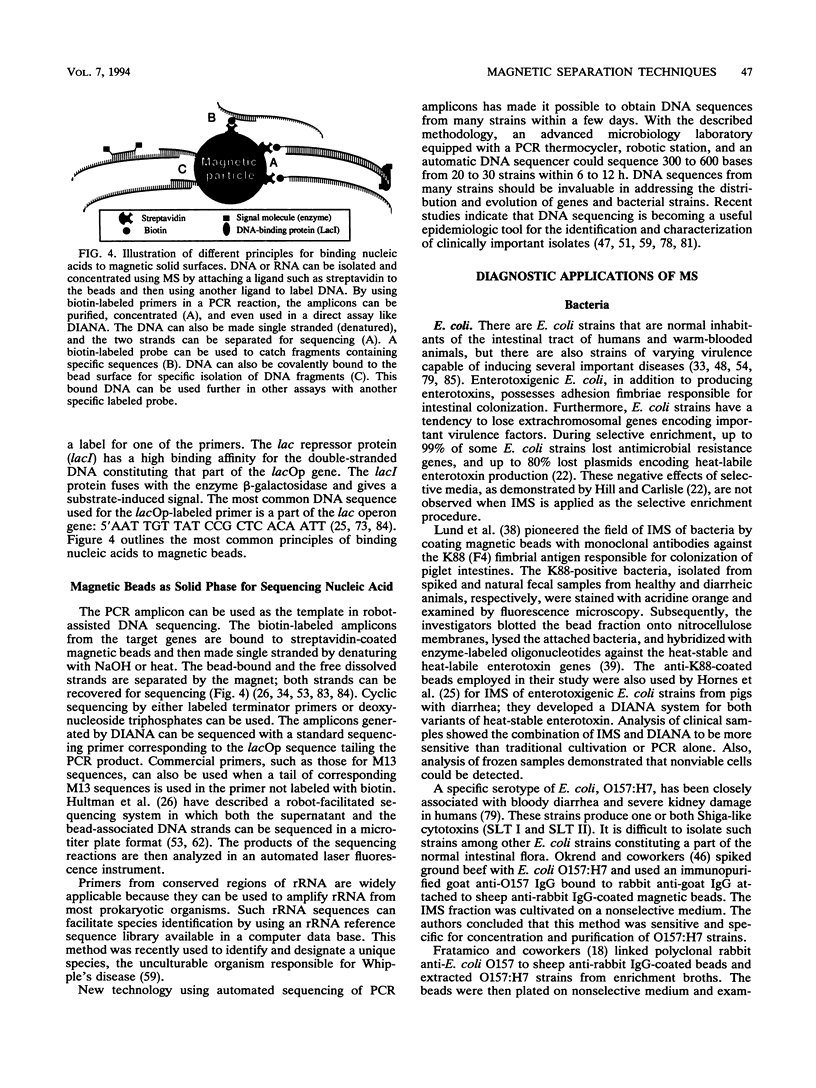

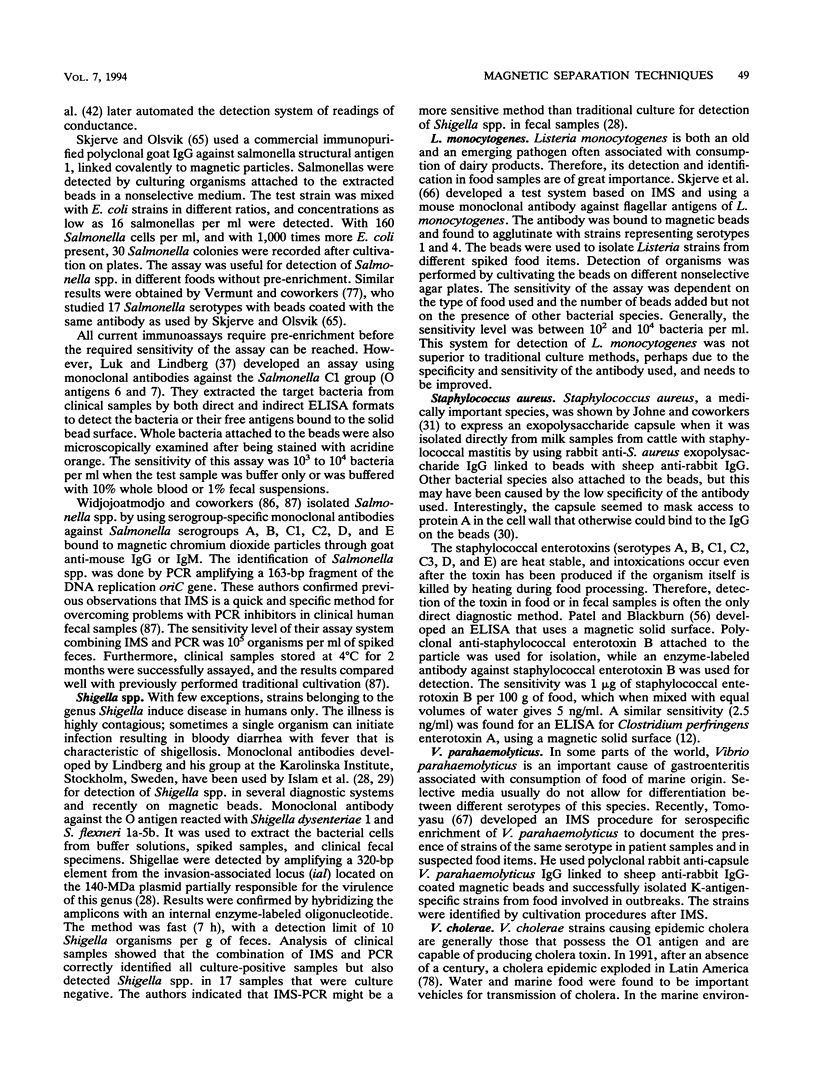
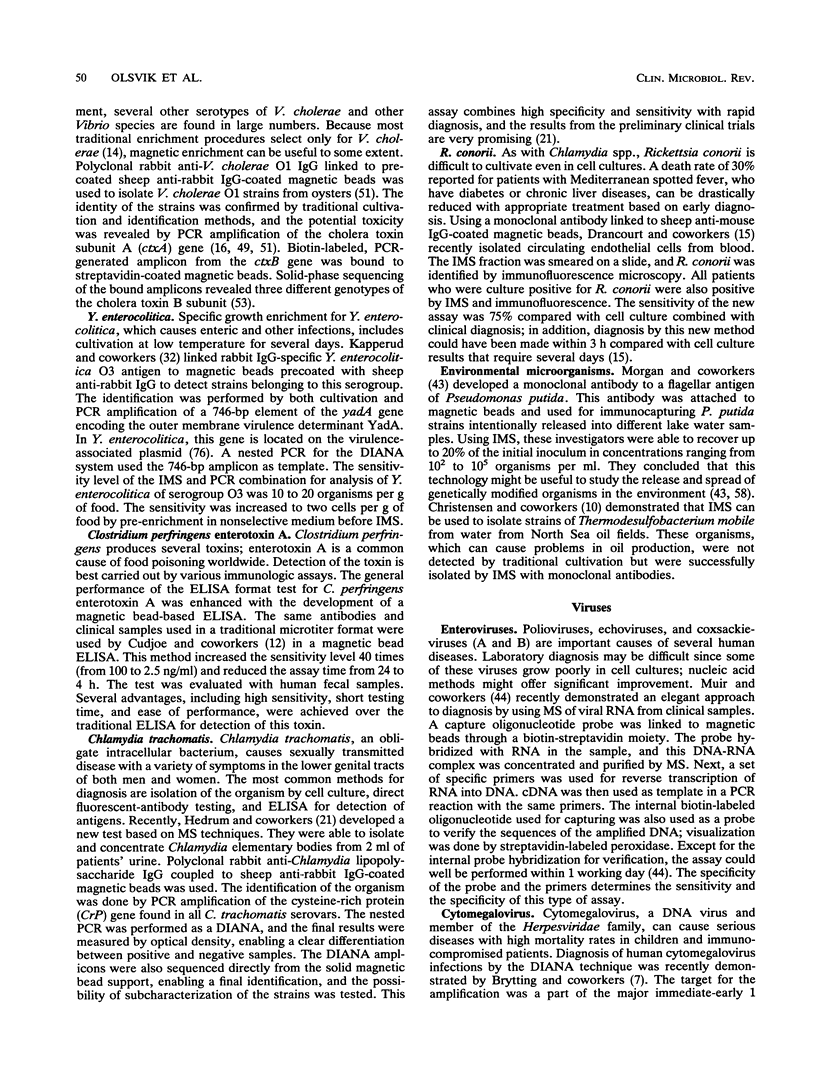

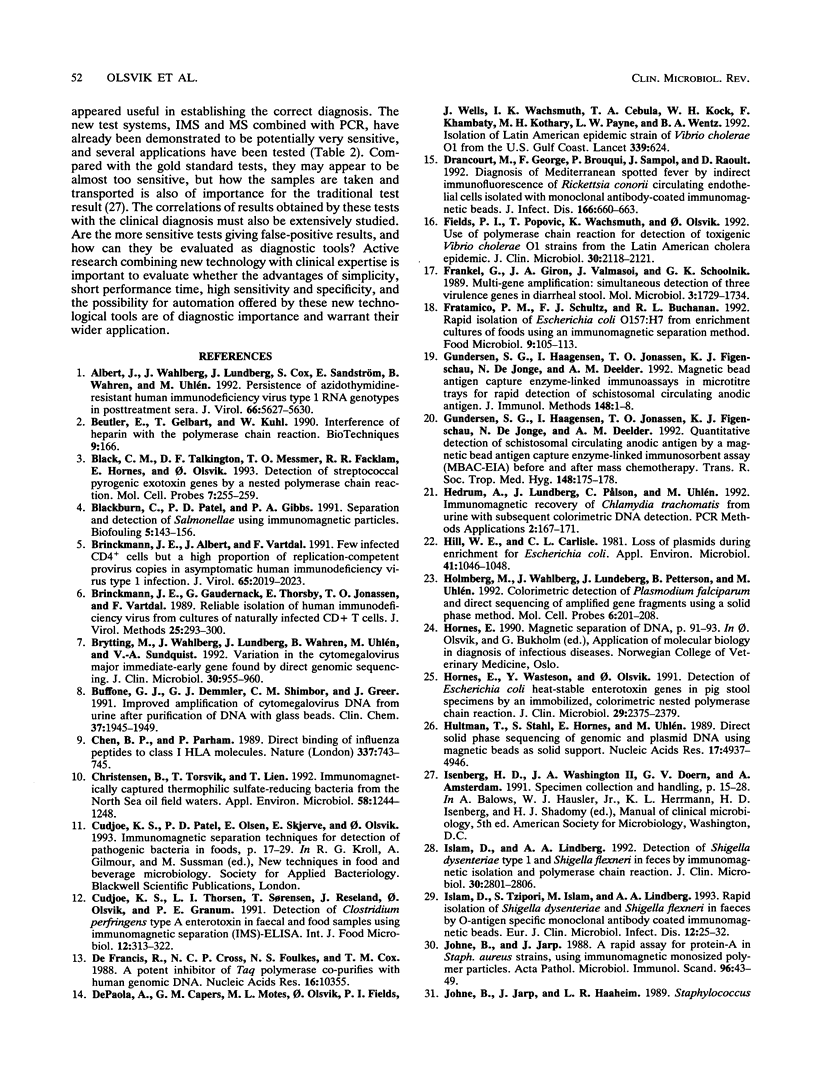

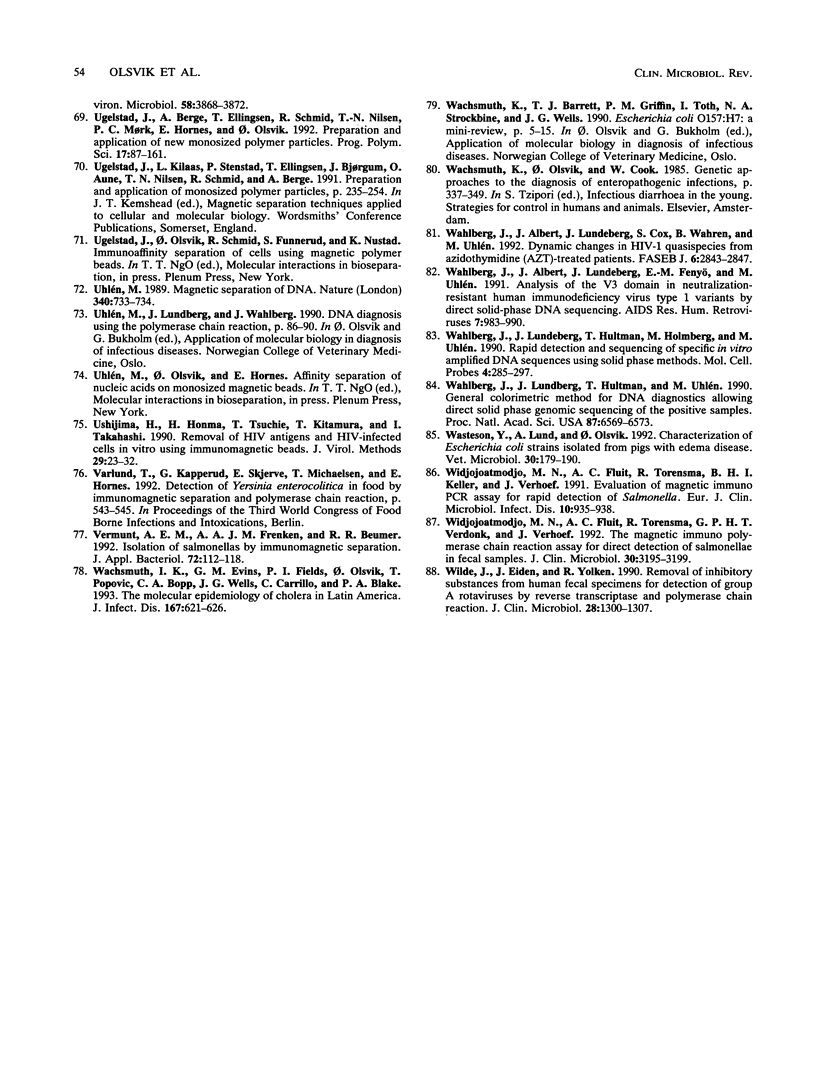
Images in this article
Selected References
These references are in PubMed. This may not be the complete list of references from this article.
- Albert J., Wahlberg J., Lundeberg J., Cox S., Sandström E., Wahren B., Uhlén M. Persistence of azidothymidine-resistant human immunodeficiency virus type 1 RNA genotypes in posttreatment sera. J Virol. 1992 Sep;66(9):5627–5630. doi: 10.1128/jvi.66.9.5627-5630.1992. [DOI] [PMC free article] [PubMed] [Google Scholar]
- Beutler E., Gelbart T., Kuhl W. Interference of heparin with the polymerase chain reaction. Biotechniques. 1990 Aug;9(2):166–166. [PubMed] [Google Scholar]
- Black C. M., Talkington D. F., Messmer T. O., Facklam R. R., Hornes E., Olsvik O. Detection of streptococcal pyrogenic exotoxin genes by a nested polymerase chain reaction. Mol Cell Probes. 1993 Aug;7(4):255–259. doi: 10.1006/mcpr.1993.1038. [DOI] [PubMed] [Google Scholar]
- Brinchmann J. E., Albert J., Vartdal F. Few infected CD4+ T cells but a high proportion of replication-competent provirus copies in asymptomatic human immunodeficiency virus type 1 infection. J Virol. 1991 Apr;65(4):2019–2023. doi: 10.1128/jvi.65.4.2019-2023.1991. [DOI] [PMC free article] [PubMed] [Google Scholar]
- Brinchmann J. E., Gaudernack G., Thorsby E., Jonassen T. O., Vartdal F. Reliable isolation of human immunodeficiency virus from cultures of naturally infected CD4+ T cells. J Virol Methods. 1989 Sep;25(3):293–300. doi: 10.1016/0166-0934(89)90056-6. [DOI] [PubMed] [Google Scholar]
- Brytting M., Wahlberg J., Lundeberg J., Wahren B., Uhlén M., Sundqvist V. A. Variations in the cytomegalovirus major immediate-early gene found by direct genomic sequencing. J Clin Microbiol. 1992 Apr;30(4):955–960. doi: 10.1128/jcm.30.4.955-960.1992. [DOI] [PMC free article] [PubMed] [Google Scholar]
- Buffone G. J., Demmler G. J., Schimbor C. M., Greer J. Improved amplification of cytomegalovirus DNA from urine after purification of DNA with glass beads. Clin Chem. 1991 Nov;37(11):1945–1949. [PubMed] [Google Scholar]
- Chen B. P., Parham P. Direct binding of influenza peptides to class I HLA molecules. Nature. 1989 Feb 23;337(6209):743–745. doi: 10.1038/337743a0. [DOI] [PubMed] [Google Scholar]
- Christensen B., Torsvik T., Lien T. Immunomagnetically captured thermophilic sulfate-reducing bacteria from north sea oil field waters. Appl Environ Microbiol. 1992 Apr;58(4):1244–1248. doi: 10.1128/aem.58.4.1244-1248.1992. [DOI] [PMC free article] [PubMed] [Google Scholar]
- Cudjoe K. S., Thorsen L. I., Sørensen T., Reseland J., Olsvik O., Granum P. E. Detection of Clostridium perfringens type A enterotoxin in faecal and food samples using immunomagnetic separation (IMS)-ELISA. Int J Food Microbiol. 1991 Apr;12(4):313–321. doi: 10.1016/0168-1605(91)90145-f. [DOI] [PubMed] [Google Scholar]
- DePaola A., Capers G. M., Motes M. L., Olsvik O., Fields P. I., Wells J., Wachsmuth I. K., Cebula T. A., Koch W. H., Khambaty F. Isolation of Latin American epidemic strain of Vibrio cholerae O1 from US Gulf Coast. Lancet. 1992 Mar 7;339(8793):624–624. doi: 10.1016/0140-6736(92)90917-r. [DOI] [PubMed] [Google Scholar]
- Drancourt M., George F., Brouqui P., Sampol J., Raoult D. Diagnosis of Mediterranean spotted fever by indirect immunofluorescence of Rickettsia conorii in circulating endothelial cells isolated with monoclonal antibody-coated immunomagnetic beads. J Infect Dis. 1992 Sep;166(3):660–663. doi: 10.1093/infdis/166.3.660. [DOI] [PubMed] [Google Scholar]
- Fields P. I., Popovic T., Wachsmuth K., Olsvik O. Use of polymerase chain reaction for detection of toxigenic Vibrio cholerae O1 strains from the Latin American cholera epidemic. J Clin Microbiol. 1992 Aug;30(8):2118–2121. doi: 10.1128/jcm.30.8.2118-2121.1992. [DOI] [PMC free article] [PubMed] [Google Scholar]
- Frankel G., Giron J. A., Valmassoi J., Schoolnik G. K. Multi-gene amplification: simultaneous detection of three virulence genes in diarrhoeal stool. Mol Microbiol. 1989 Dec;3(12):1729–1734. doi: 10.1111/j.1365-2958.1989.tb00158.x. [DOI] [PubMed] [Google Scholar]
- Gundersen S. G., Haagensen I., Jonassen T. O., Figenschau K. J., de Jonge N., Deelder A. M. Magnetic bead antigen capture enzyme-linked immunoassay in microtitre trays for rapid detection of schistosomal circulating anodic antigen. J Immunol Methods. 1992 Apr 8;148(1-2):1–8. doi: 10.1016/0022-1759(92)90151-i. [DOI] [PubMed] [Google Scholar]
- Gundersen S. G., Haagensen I., Jonassen T. O., Figenschau K. J., de Jonge N., Deelder A. M. Quantitative detection of schistosomal circulating anodic antigen by a magnetic bead antigen capture enzyme-linked immunosorbent assay (MBAC-EIA) before and after mass chemotherapy. Trans R Soc Trop Med Hyg. 1992 Mar-Apr;86(2):175–178. doi: 10.1016/0035-9203(92)90559-u. [DOI] [PubMed] [Google Scholar]
- Hedrum A., Lundeberg J., Påhlson C., Uhlén M. Immunomagnetic recovery of Chlamydia trachomatis from urine with subsequent colorimetric DNA detection. PCR Methods Appl. 1992 Nov;2(2):167–171. doi: 10.1101/gr.2.2.167. [DOI] [PubMed] [Google Scholar]
- Hill W. E., Carlisle C. L. Loss of plasmids during enrichment for Escherichia coli. Appl Environ Microbiol. 1981 Apr;41(4):1046–1048. doi: 10.1128/aem.41.4.1046-1048.1981. [DOI] [PMC free article] [PubMed] [Google Scholar]
- Holmberg M., Wahlberg J., Lundeberg J., Pettersson U., Uhlén M. Colorimetric detection of Plasmodium falciparum and direct sequencing of amplified gene fragments using a solid phase method. Mol Cell Probes. 1992 Jun;6(3):201–208. doi: 10.1016/0890-8508(92)90017-r. [DOI] [PubMed] [Google Scholar]
- Hornes E., Wasteson Y., Olsvik O. Detection of Escherichia coli heat-stable enterotoxin genes in pig stool specimens by an immobilized, colorimetric, nested polymerase chain reaction. J Clin Microbiol. 1991 Nov;29(11):2375–2379. doi: 10.1128/jcm.29.11.2375-2379.1991. [DOI] [PMC free article] [PubMed] [Google Scholar]
- Hultman T., Ståhl S., Hornes E., Uhlén M. Direct solid phase sequencing of genomic and plasmid DNA using magnetic beads as solid support. Nucleic Acids Res. 1989 Jul 11;17(13):4937–4946. doi: 10.1093/nar/17.13.4937. [DOI] [PMC free article] [PubMed] [Google Scholar]
- Islam D., Lindberg A. A. Detection of Shigella dysenteriae type 1 and Shigella flexneri in feces by immunomagnetic isolation and polymerase chain reaction. J Clin Microbiol. 1992 Nov;30(11):2801–2806. doi: 10.1128/jcm.30.11.2801-2806.1992. [DOI] [PMC free article] [PubMed] [Google Scholar]
- Islam D., Tzipori S., Islam M., Lindberg A. A. Rapid detection of Shigella dysenteriae and Shigella flexneri in faeces by an immunomagnetic assay with monoclonal antibodies. Eur J Clin Microbiol Infect Dis. 1993 Jan;12(1):25–32. doi: 10.1007/BF01997052. [DOI] [PubMed] [Google Scholar]
- Johne B., Jarp J. A rapid assay for protein-A in Staph. aureus strains, using immunomagnetic monosized polymer particles. APMIS. 1988 Jan;96(1):43–49. [PubMed] [Google Scholar]
- Johne B., Jarp J., Haaheim L. R. Staphylococcus aureus exopolysaccharide in vivo demonstrated by immunomagnetic separation and electron microscopy. J Clin Microbiol. 1989 Jul;27(7):1631–1635. doi: 10.1128/jcm.27.7.1631-1635.1989. [DOI] [PMC free article] [PubMed] [Google Scholar]
- Krogfelt K. A. Bacterial adhesion: genetics, biogenesis, and role in pathogenesis of fimbrial adhesins of Escherichia coli. Rev Infect Dis. 1991 Jul-Aug;13(4):721–735. doi: 10.1093/clinids/13.4.721. [DOI] [PubMed] [Google Scholar]
- Lewis J. G., Chang G. J., Lanciotti R. S., Trent D. W. Direct sequencing of large flavivirus PCR products for analysis of genome variation and molecular epidemiological investigations. J Virol Methods. 1992 Jul;38(1):11–23. doi: 10.1016/0166-0934(92)90165-a. [DOI] [PubMed] [Google Scholar]
- Lo Y. M., Mehal W. Z., Fleming K. A. False-positive results and the polymerase chain reaction. Lancet. 1988 Sep 17;2(8612):679–679. doi: 10.1016/s0140-6736(88)90487-4. [DOI] [PubMed] [Google Scholar]
- Luk J. M., Lindberg A. A. Rapid and sensitive detection of Salmonella (O:6,7) by immunomagnetic monoclonal antibody-based assays. J Immunol Methods. 1991 Mar 1;137(1):1–8. doi: 10.1016/0022-1759(91)90387-u. [DOI] [PubMed] [Google Scholar]
- Lund A., Hellemann A. L., Vartdal F. Rapid isolation of K88+ Escherichia coli by using immunomagnetic particles. J Clin Microbiol. 1988 Dec;26(12):2572–2575. doi: 10.1128/jcm.26.12.2572-2575.1988. [DOI] [PMC free article] [PubMed] [Google Scholar]
- Lund A., Wasteson Y., Olsvik O. Immunomagnetic separation and DNA hybridization for detection of enterotoxigenic Escherichia coli in a piglet model. J Clin Microbiol. 1991 Oct;29(10):2259–2262. doi: 10.1128/jcm.29.10.2259-2262.1991. [DOI] [PMC free article] [PubMed] [Google Scholar]
- Lundeberg J., Wahlberg J., Holmberg M., Pettersson U., Uhlén M. Rapid colorimetric detection of in vitro amplified DNA sequences. DNA Cell Biol. 1990 May;9(4):287–292. doi: 10.1089/dna.1990.9.287. [DOI] [PubMed] [Google Scholar]
- Mayer L. W. Use of plasmid profiles in epidemiologic surveillance of disease outbreaks and in tracing the transmission of antibiotic resistance. Clin Microbiol Rev. 1988 Apr;1(2):228–243. doi: 10.1128/cmr.1.2.228. [DOI] [PMC free article] [PubMed] [Google Scholar]
- Morgan J. A., Winstanley C., Pickup R. W., Saunders J. R. Rapid Immunocapture of Pseudomonas putida Cells from Lake Water by Using Bacterial Flagella. Appl Environ Microbiol. 1991 Feb;57(2):503–509. doi: 10.1128/aem.57.2.503-509.1991. [DOI] [PMC free article] [PubMed] [Google Scholar]
- Muir P., Nicholson F., Jhetam M., Neogi S., Banatvala J. E. Rapid diagnosis of enterovirus infection by magnetic bead extraction and polymerase chain reaction detection of enterovirus RNA in clinical specimens. J Clin Microbiol. 1993 Jan;31(1):31–38. doi: 10.1128/jcm.31.1.31-38.1993. [DOI] [PMC free article] [PubMed] [Google Scholar]
- Olsvik O., Rimstad E., Hornes E., Strockbine N., Wasteson Y., Lund A., Wachsmuth K. A nested PCR followed by magnetic separation of amplified fragments for detection of Escherichia coli Shiga-like toxin genes. Mol Cell Probes. 1991 Dec;5(6):429–435. doi: 10.1016/s0890-8508(05)80014-3. [DOI] [PubMed] [Google Scholar]
- Olsvik O., Wahlberg J., Petterson B., Uhlén M., Popovic T., Wachsmuth I. K., Fields P. I. Use of automated sequencing of polymerase chain reaction-generated amplicons to identify three types of cholera toxin subunit B in Vibrio cholerae O1 strains. J Clin Microbiol. 1993 Jan;31(1):22–25. doi: 10.1128/jcm.31.1.22-25.1993. [DOI] [PMC free article] [PubMed] [Google Scholar]
- Olsvik O., Wasteson Y., Lund A., Hornes E. Pathogenic Escherichia coli found in food. Int J Food Microbiol. 1991 Jan;12(1):103–113. doi: 10.1016/0168-1605(91)90051-p. [DOI] [PubMed] [Google Scholar]
- Persing D. H. Polymerase chain reaction: trenches to benches. J Clin Microbiol. 1991 Jul;29(7):1281–1285. doi: 10.1128/jcm.29.7.1281-1285.1991. [DOI] [PMC free article] [PubMed] [Google Scholar]
- Pickup R. W., Saunders J. R. Detection of genetically engineered traits among bacteria in the environment. Trends Biotechnol. 1990 Nov;8(11):329–335. doi: 10.1016/0167-7799(90)90214-i. [DOI] [PubMed] [Google Scholar]
- Relman D. A., Schmidt T. M., MacDermott R. P., Falkow S. Identification of the uncultured bacillus of Whipple's disease. N Engl J Med. 1992 Jul 30;327(5):293–301. doi: 10.1056/NEJM199207303270501. [DOI] [PubMed] [Google Scholar]
- Rimstad E., Hornes E., Olsvik O., Hyllseth B. Identification of a double-stranded RNA virus by using polymerase chain reaction and magnetic separation of the synthesized DNA segments. J Clin Microbiol. 1990 Oct;28(10):2275–2278. doi: 10.1128/jcm.28.10.2275-2278.1990. [DOI] [PMC free article] [PubMed] [Google Scholar]
- Schofield J. P., Vaudin M., Kettle S., Jones D. S. A rapid semi-automated microtiter plate method for analysis and sequencing by PCR from bacterial stocks. Nucleic Acids Res. 1989 Nov 25;17(22):9498–9498. doi: 10.1093/nar/17.22.9498. [DOI] [PMC free article] [PubMed] [Google Scholar]
- Seesod N., Lunderberg J., Hedrum A., Aslund L., Holder A., Thaithong S., Uhlén M. Immunomagnetic purification to facilitate DNA diagnosis of Plasmodium falciparum. J Clin Microbiol. 1993 Oct;31(10):2715–2719. doi: 10.1128/jcm.31.10.2715-2719.1993. [DOI] [PMC free article] [PubMed] [Google Scholar]
- Skjerve E., Olsvik O. Immunomagnetic separation of Salmonella from foods. Int J Food Microbiol. 1991 Oct;14(1):11–17. doi: 10.1016/0168-1605(91)90032-k. [DOI] [PubMed] [Google Scholar]
- Skjerve E., Rørvik L. M., Olsvik O. Detection of Listeria monocytogenes in foods by immunomagnetic separation. Appl Environ Microbiol. 1990 Nov;56(11):3478–3481. doi: 10.1128/aem.56.11.3478-3481.1990. [DOI] [PMC free article] [PubMed] [Google Scholar]
- Tomoyasu T. Development of the immunomagnetic enrichment method selective for Vibrio parahaemolyticus serotype K and its application to food poisoning study. Appl Environ Microbiol. 1992 Aug;58(8):2679–2682. doi: 10.1128/aem.58.8.2679-2682.1992. [DOI] [PMC free article] [PubMed] [Google Scholar]
- Uhlen M. Magnetic separation of DNA. Nature. 1989 Aug 31;340(6236):733–734. doi: 10.1038/340733a0. [DOI] [PubMed] [Google Scholar]
- Ushijima H., Honma H., Tsuchie H., Kitamura T., Takahashi I. Removal of HIV antigens and HIV-infected cells in vitro using immunomagnetic beads. J Virol Methods. 1990 Jul;29(1):23–31. doi: 10.1016/0166-0934(90)90004-y. [DOI] [PubMed] [Google Scholar]
- Vermunt A. E., Franken A. A., Beumer R. R. Isolation of salmonellas by immunomagnetic separation. J Appl Bacteriol. 1992 Feb;72(2):112–118. doi: 10.1111/j.1365-2672.1992.tb01811.x. [DOI] [PubMed] [Google Scholar]
- Wachsmuth I. K., Evins G. M., Fields P. I., Olsvik O., Popovic T., Bopp C. A., Wells J. G., Carrillo C., Blake P. A. The molecular epidemiology of cholera in Latin America. J Infect Dis. 1993 Mar;167(3):621–626. doi: 10.1093/infdis/167.3.621. [DOI] [PubMed] [Google Scholar]
- Wahlberg J., Albert J., Lundeberg J., Cox S., Wahren B., Uhlén M. Dynamic changes in HIV-1 quasispecies from azidothymidine (AZT)-treated patients. FASEB J. 1992 Jul;6(10):2843–2847. doi: 10.1096/fasebj.6.10.1634047. [DOI] [PubMed] [Google Scholar]
- Wahlberg J., Albert J., Lundeberg J., Von Gegerfelt A., Broliden K., Utter G., Fenyö E. M., Uhlén M. Analysis of the V3 loop in neutralization-resistant human immunodeficiency virus type 1 variants by direct solid-phase DNA sequencing. AIDS Res Hum Retroviruses. 1991 Dec;7(12):983–990. doi: 10.1089/aid.1991.7.983. [DOI] [PubMed] [Google Scholar]
- Wahlberg J., Lundeberg J., Hultman T., Holmberg M., Uhlén M. Rapid detection and sequencing of specific in vitro amplified DNA sequences using solid phase methods. Mol Cell Probes. 1990 Aug;4(4):285–297. doi: 10.1016/0890-8508(90)90020-z. [DOI] [PubMed] [Google Scholar]
- Wahlberg J., Lundeberg J., Hultman T., Uhlén M. General colorimetric method for DNA diagnostics allowing direct solid-phase genomic sequencing of the positive samples. Proc Natl Acad Sci U S A. 1990 Sep;87(17):6569–6573. doi: 10.1073/pnas.87.17.6569. [DOI] [PMC free article] [PubMed] [Google Scholar]
- Wasteson Y., Lund A., Olsvik O. Characterization of Escherichia coli strains isolated from pigs with edema disease. Vet Microbiol. 1992 Feb;30(2-3):179–190. doi: 10.1016/0378-1135(92)90112-7. [DOI] [PubMed] [Google Scholar]
- Widjojoatmodjo M. N., Fluit A. C., Torensma R., Keller B. H., Verhoef J. Evaluation of the magnetic immuno PCR assay for rapid detection of Salmonella. Eur J Clin Microbiol Infect Dis. 1991 Nov;10(11):935–938. doi: 10.1007/BF02005447. [DOI] [PubMed] [Google Scholar]
- Widjojoatmodjo M. N., Fluit A. C., Torensma R., Verdonk G. P., Verhoef J. The magnetic immuno polymerase chain reaction assay for direct detection of salmonellae in fecal samples. J Clin Microbiol. 1992 Dec;30(12):3195–3199. doi: 10.1128/jcm.30.12.3195-3199.1992. [DOI] [PMC free article] [PubMed] [Google Scholar]
- Wilde J., Eiden J., Yolken R. Removal of inhibitory substances from human fecal specimens for detection of group A rotaviruses by reverse transcriptase and polymerase chain reactions. J Clin Microbiol. 1990 Jun;28(6):1300–1307. doi: 10.1128/jcm.28.6.1300-1307.1990. [DOI] [PMC free article] [PubMed] [Google Scholar]
- de Franchis R., Cross N. C., Foulkes N. S., Cox T. M. A potent inhibitor of Taq polymerase copurifies with human genomic DNA. Nucleic Acids Res. 1988 Nov 11;16(21):10355–10355. doi: 10.1093/nar/16.21.10355. [DOI] [PMC free article] [PubMed] [Google Scholar]



